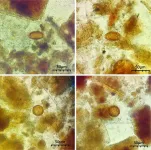(Press-News.org) CHAPEL HILL, North Carolina--A comprehensive review by University of North Carolina researchers and colleagues highlights the optimal ways that focused, high-dose radiation can be delivered to various types of tumors while sparing normal tissue and mitigating long-term side effects. The review was reported as a special issue in the International Journal of Radiation Oncology, Biology, Physics on May 1, 2021.
This analysis was based on an exhaustive review of data and the literature published largely in the past decade. It updates an earlier review that primarily focused on the effects of conventional radiation therapy on normal tissue. This new review also includes important analyses of how well high-dose radiation can destroy small tumors, such as small brain lesions, lung lesions, and cancers that metastasize to other parts of the body.
"We undertook this review because we have an ever-increasing knowledge about the dose and volume of tissue to which we can direct radiation to both eradicate tumors while also safeguarding the surrounding normal tissue," said Lawrence B. Marks, MD, chair of the UNC Department of Radiation Oncology and Dr. Sidney K. Simon Distinguished Professor of Oncology Research at UNC Lineberger Comprehensive Cancer Center. "Today, we are better able to tailor radiotherapy to optimize benefit and minimize risk."
Conventional radiotherapy, developed nearly a century ago, often broadly hits the tumor and some healthy tissue surrounding the tumor, and is administered in low daily doses, usually over many weeks. For some patients, their cancer can be treated with more advanced techniques, called stereotactic body radiation therapy, or radiosurgery, that target smaller areas of tissue that are primarily cancerous, treating them at a high dose per day and usually administered for one to five days. These radiosurgery treatments are the focus of this recently published report.
Marks said UNC is a leader in radiosurgery treatments. "We are lucky to have specialized equipment and expertise to deliver these types of treatments." He added that UNC's multidisciplinary approach to cancer care brings together clinical collaborators to work in partnership with radiosurgery program to care for a wide range of cancers, including brain, thoracic, gastrointestinal and genitourinary cancers.
"New computational methods and machines allow us to deliver radiotherapy much more accurately today, allowing us to limit the area where the radiation is targeted, thereby giving us the ability to increase the dose per day," Marks said. "However, at this point in time we can only use this approach for smallish-sized tumors, but newer techniques may allow us to extend this approach to larger tumors as well."
Because it takes years for data to accrue and mature, the next review will be done when there are discernable shifts or changes in treatment practice patterns, according to the authors. However, there is a large review due out next year, in which Marks is participating, that is focusing on use of radiotherapy in pediatric cancers. Radiotherapy is often used sparingly in children due to later-in-life side effects, therefore making it important to know when best to use these treatments.
"Radiation therapy is now safer than ever. Our analysis will help support the growing use of the latest forms of radiotherapy, which are proving to be a very effective in treating many primary and metastatic lesions," Marks concluded.
INFORMATION:
In addition to Marks, the other authors from UNC include Shiva Das, PhD, Nathan Sheets, MD, Panayiotis Mavroidis, PhD, DABR, and Trevor Royce, MD, MPH. Other members of Marks' steering committee include Jimm Grimm, PhD, Geisinger Cancer Institute, Danville, PA, and Thomas Jefferson University, Philadelphia; Andrew Jackson, PhD, and Ellen Yorke, PhD, Memorial Sloan-Kettering Cancer Center, New York; Brian D. Kavanagh, MD, University of Colorado School of Medicine, Aurora, CO; and Jinyu Xue, PhD, NYU Langone Medical Center, New York.
Exposure to air pollution, even over the course of just a few weeks, can impede mental performance, according to a new study led by researchers at Columbia University Mailman School of Public Health. However, these adverse effects were lessened in people taking nonsteroidal anti-inflammatory drugs (NSAIDs) like aspirin. The study is among the first to explore short-term air pollution exposures and the use of NSAIDs to mitigate their effects. The results are published in the journal Nature Aging.
Examples of events that would increase someone's exposure to air pollution over the short term could include forest fires, smog, second-hand cigarette smoke, charcoal ...
The Bornean subspecies of Rajah scops owl (Otus brookii brookii), documented in the wild for the first time since 1892, may be its own unique species and deserving of a conservation designation. Published April 28 in The Wilson Journal of Ornithology, Smithsonian Migratory Bird Center ecologist Andy Boyce reported the rediscovery and photographed this elusive subspecies in the mountainous forests of Mount Kinabalu in Sabah, Malaysia.
"It was a pretty rapid progression of emotions when I first saw the owl--absolute shock and excitement that we'd found this mythical bird, then pure anxiety that I had to document it as fast as I could," Boyce said. "Based on size, eye color and habitat, I knew it was the Bornean Rajah scops owl. What's more, taking into ...
East Hanover, NJ. May 3, 2021. An international team of multiple sclerosis (MS) researchers showed that longitudinal changes in social cognition are associated with psychological outcomes of daily living, suggesting that social cognition may exert a central role in people with MS. The article, "Social Cognition in Multiple Sclerosis: A 3-Year Follow-Up MRI and Behavioral Study" (doi: 10.3390/diagnostics11030484) was published on March 9, 2021, in Diagnostics. It is available open access at https://www.ncbi.nlm.nih.gov/pmc/articles/PMC8001246/.
The authors are Helen M. Genova, PhD, of Kessler Foundation's Center for Neuropsychology ...
Individuals living with severe Alzheimer's disease showed remarkable improvements in behaviour and cognition within days of receiving an innovative new treatment that delivered low doses of radiation, a recent Baycrest-Sunnybrook pilot study found.
"The primary goal of a therapy for Alzheimer's disease should be to improve the patient's quality of life. We want to optimize their well-being and restore communication with family and friends to avoid social isolation, loneliness and under-stimulation. Although the study was a small pilot and should be interpreted with caution, our results suggest that low-dose radiation therapy may successfully achieve this," says Dr. Morris Freedman, scientist at Baycrest's Rotman Research ...
In the early 19th century in North America, parasitic infections were quite common in urban areas due in part to population growth and urbanization. Prior research has found that poor sanitation, unsanitary privy (outhouse) conditions, and increased contact with domestic animals, contributed to the prevalence of parasitic disease in urban areas. A new study examining fecal samples from a privy on Dartmouth's campus illustrates how rural wealthy elites in New England also had intestinal parasitic infections. The findings are published in the Journal of Archeological Science: Reports.
"Our study is one of the first to demonstrate evidence of parasitic infection in an affluent rural household in the Northeast," says co-author Theresa Gildner, who was ...
New research shows that patients who have had contact with the hospital due to serious glandular disease have a greater risk of subsequently developing depression. The study from iPSYCH is the largest yet to show a correlation between glandular fever and depression.
The vast majority of Danes have had glandular fever - also called mononucleosis - before adulthood. And for the vast majority of them, the disease can be cured at home with throat lozenges and a little extra care. But for some, the disease is so serious that they need to visit the hospital.
A new research result now shows that precisely those patients who have been in contact with the hospital in connection with their illness, have a greater risk of suffering a depression later.
"Our study ...
AUSTIN, Texas -- For people experiencing homelessness, missing proof of identity can be a major barrier to receiving critical services, from housing to food assistance to health care. Physical documents such as driver's licenses are highly susceptible to loss, theft or damage. However, researchers from Dell Medical School at The University of Texas at Austin say new technology solutions such as blockchain can be used to keep important health care information secure and portable.
"Health care institutions and social services are so fragmented and siloed they're unable to accurately collect, share or verify basic identity information about a person experiencing homelessness," said Tim Mercer, M.D., MPH, director ...
A study encompassing some 9,000 dogs conducted at the University of Helsinki demonstrated that fearfulness, age, breed, the company of other members of the same species and the owner's previous experience of dogs were associated with aggressive behaviour towards humans. The findings can potentially provide tools for understanding and preventing aggressive behaviour.
Aggressive behaviour in dogs can include growling, barking, snapping and biting. These gestures are part of normal canine communication, and they also occur in non-aggressive situations, such as during play. However, aggressive behaviour ...
An extraordinary discovery in the Gulf of Eilat: Researchers from Tel Aviv University have discovered a species of ascidian, a marine animal commonly found in the Gulf of Eilat, capable of regenerating all of its organs - even if it is dissected into three fragments. The study was led by Prof. Noa Shenkar, Prof. Dorothee Huchon-Pupko, and Tal Gordon of Tel Aviv University's School of Zoology at the George S. Wise Faculty of Life Sciences and the Steinhardt Museum of Natural History. The findings of this surprising discovery were published in the leading journal Frontiers in Cell and Developmental Biology.
"It is an astounding discovery, as this is an animal that belongs to the Phylum Chordata - animals with a dorsal cord - which also includes us humans," explains Prof. Noa ...
Water is a scarce resource in many of the Earth's ecosystems. This scarcity is likely to increase in the course of climate change. This, in turn, might lead to a considerable decline in plant diversity. Using experimental data from all over the world, scientists from the Helmholtz Centre for Environmental Research (UFZ), the German Centre for Integrative Biodiversity Research (iDiv), and the Martin Luther University of Halle-Wittenberg (MLU) have demonstrated for the first time that plant biodiversity in drylands is particularly sensitive to changes in precipitation. In an article published in Nature Communications, the team warns that this can also have consequences for the people living in the ...






